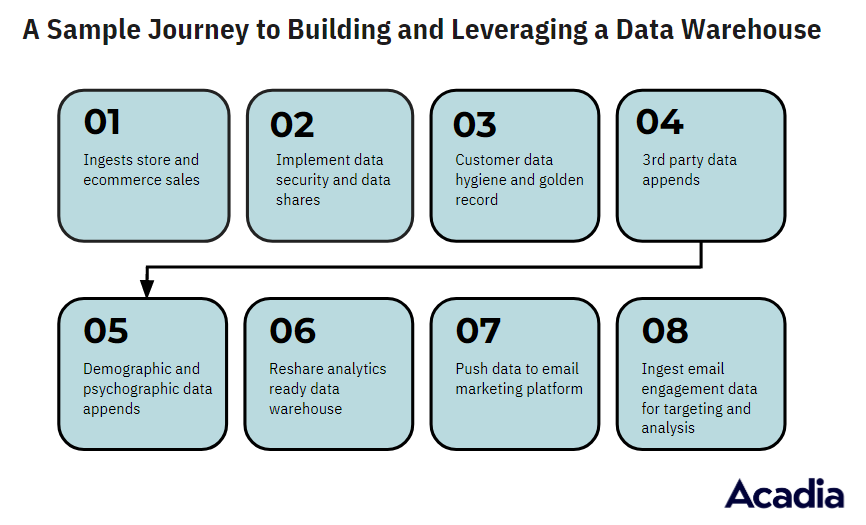Customer Data Platforms are having a moment. As privacy changes from Apple and Google continue to shake up the digital ad industry, many brands are asking themselves: What can we do with our own first-party data?
The answer, as we discuss in more depth here, is to build a Customer Data Platform (CDP). CDPs bring together all of the first-party information you have gathered from your e-commerce site, in-person point-of-sale systems, and more. To improve your ad-targeting abilities, they also integrate with third-party marketing platforms like Facebook or Amazon Marketing Cloud.
Building a CDP can sound daunting at first. Many CDPs are pitched as all-in-one solutions, in which a single software company handles every aspect of your CDP. This can get pricey. On average, the all-in-one solution tends to cost between $100k and $300k of upfront investment.
The reality is, all-in-one bundles are neither the most cost-effective nor the most dynamic solution. Building a CDP is a complicated, 8-step process. Often, my clients tell me that the all-in-one solution excels at certain aspects of the CDP but becomes a meaningful roadblock for others. It’s hard for one software to do everything well.
Our recommendation: Compose your own CDP
Rather than choose an all-in-one CDP solution, we recommend that you aggregate a bunch of different tools into a single CDP, tailored to your specific needs. We call this a “composable CDP.”
It has never been easier to unbundle your CDP. As more data shifts to the cloud, breaking up your CDP into segments is easier than ever. With tools like Snowflake, Amazon Redshift, and Google’s BigQuery, you can build a data warehouse in the cloud that integrates with a variety of other other tools.
Snowflake in particular is built to maximize shareability. When your data lives in Snowflake, outside software companies can view it—in a privacy-safe and security-safe manner—directly in Snowflake. That means you don’t have to go through all of the trouble of copying those reams of data into other software platforms.
For instance, you can pair a warehouse in Snowflake with a software like LiveRamp, which is designed to match online and offline customers (a process called customer identity resolution).
A composable approach puts CDPs in reach of small brands. You can tailor a composable CDP to your specific needs and budget. In other words, you don’t have to be doing major numbers for these tools to have value. I work with brands making under $10 million in revenue per year that warehouse their data in Snowflake.
Want to learn more about what’s possible with customer measurement? We have a free guide coming out in March, the 4 stages of customer data maturity. Sign up for our email newsletter to receive it when it goes live.
Hiring outside help is easy. An outside contractor can easily build you a CDP, then give you the “keys” to take it over. Composable CDPs are easily transferable, and you won’t be locked in for the long term.
Of course, some brands may want to hire an in-house employee who can act as a CDP manager and do all of this work themselves. But I’ve seen pitfalls with that approach. If someone becomes an in-house jack-of-all trades when it comes to your CDP, and they find a job elsewhere, they can leave you in a lurch. It’s therefore critical to ensure that CDP expertise is spread out across your teams.
Bring in outside help only where you need it most
As I mentioned, building a CDP is an 8-step process. It starts with creating a data warehouse to ingest your customer data, then evolves into matching up customers based on digital identifiers, and then concludes with pushing that data out to third-platform ad platforms.
Let’s say your in-house team can confidently do 5 of those 8 steps, but not the remaining 3. With a composable CDP, you can hire outside experts to fill in the gaps.

You do steps 1-2, we do steps 4-6. Brands often hire us to create specific segments of their CDP.
At Acadia, we recently worked with a large specialty retailer that had its own, in-house data team. The retailer had already built a data warehouse for itself in Snowflake, which encompassed transaction information from both its e-commerce site and its network of physical stores.
The problem was, the retailer was not able to tie all of that information together. If a customer gave slightly different personal identifiers in store vs. online—for instance, different emails or full names—then the retailer could not quickly detect that this was the same person.
The retailer hired us to help resolve this. Our analytics team used customer identifiers to link in-store customers to online shoppers. Then we took that data a step further. Now that we had insights about the transaction behavior of each customer, we built a predictive model on top of the CDP that estimated how likely a certain customer was to make another purchase.
From there, the retailer pushed out that predictive data to advertising platforms like Message Gears, their email marketing platform and Attentive, their SMS provider. That way, the retailer could allocate its investment and messaging more efficiently. With the predictions we generated from the CDP, the retailer could target only the people most likely to convert in the future.
We saved this particular client $100k in costs on its CDP, and we can do the same for brands across a variety of budgets and capabilities. Whether you want a team to build you a full CDP from scratch, or you simply want someone to come into a project halfway through and improve specific aspects, Acadia can do it all. Learn more about how our Analytics team can help here.

